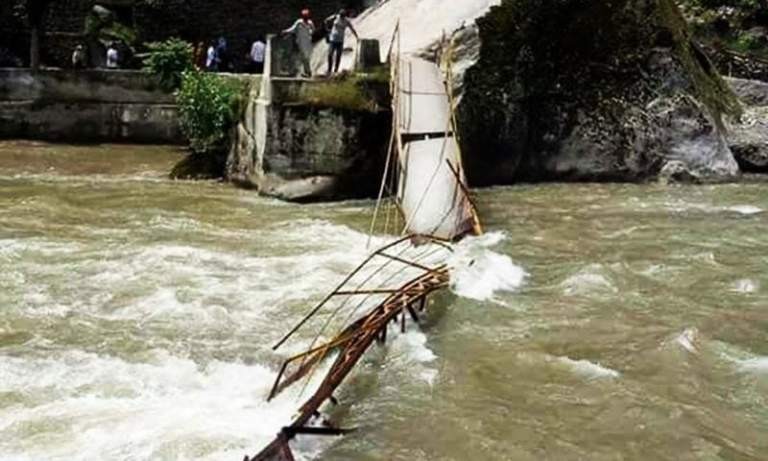
With the breaking of a hanging bridge that caused 12 deaths, other life-threatening infrastructures such as broken roads have come to the fore

The tragic collapse of a wooden footbridge in the Neelum Valley, 118km northeast of Islamabad, that drowned 12 students sent shock waves across Pakistan. It was a rare accident in which tourists, mostly young students, lost their lives in Azad Jammu and Kashmir (AJK). According to news reports, 157 tourists arrived in Neelum Valley, 70 of them were students from TIPS College, Faisalabad, 64 from Sahiwal Medical College, Sahiwal, and 23 others.
The local authorities point at a warning board which states that the bridge cannot withstand the load of more than five people at a time. Overlooking this counsel, 20 to 25 students stood on the footbridge to view the landscape of the Valley and take pictures and selfies. Moments later, the bridge came crashing down and a tragedy occurred that could have been averted with a little care.
The absence of mobile connectivity worsened the situation. Neelum Valley is the only region of AJK which has limited mobile connectivity due to its proximity to the Line of Control. Authorities have not allowed mobile companies to establish their network in the region, fearing potential Indian incursion. Consequently, families of victims could not contact their loved ones and had to travel to Neelum Valley or Muzaffarabad to learn if they were alive and well.
On the whole, inadequate health, rescue and evacuation facilities are major issues in the remote areas of AJK. However, Neelum Valley is worst off district in the belt; health staff is hardly visible there. And during this accident of the hanging bridge, the civil administration’s vulnerability was exposed to the nation.
The valley receives hundreds of thousands of tourists every year, despite the fact that the district administration has no boats or divers to rescue tourists in case they drown. This should be a basic requirement in tourist destinations.
It was common Pakistani citizens who rescued the drowning people. A 12-year-old local resident, Saim Shifat, the son of a pakora wallah, wrote a new chapter in the history of human sacrifices. While attempting to save a life, he was swept away to his death. People across Pakistan appreciated his sacrifice, particularly on social media, and recommended the government give him a national award. Owing to public demand, the AJK Government announced to rename Kundalshai Bridge after Saim Shifat.
There has been an influx of tourists in the picturesque Neelum Valley in recent years. Neelum Valley is one of the most beautiful places on earth. People call it a ‘Chota Kashmir’ (small Kashmir) because a number of the unique resorts, rivers, waterfalls, high-lands, wildlife and tourist destinations which resembles the Kashmir Valley, on the other side of the Line of Control, are located here.
Javaid Ayub, the director general of AJK’s Tourism and Archaeology department, told The News on Sunday that during the last three years over 3.6 million tourists travelled to AJK and a large chunk of them visit Neelum Valley. In 2017, 14.5 million tourists visited AJK and almost half of went to the Neelum Valley.
Of late, local tourism in Pakistan has grown. A new and emerging middle class, particularly from the urban areas, are keen to explore the country. The peace, hospitality and nearly zero crime rate in AJK attract and mesmerize tourists.
Young Kashmiri entrepreneurs have found an opportunity to establish their businesses to cater to these tourists. Several tour companies have been established in AJK, with offices in Islamabad, Lahore and Karachi. Social media has also played an instrumental role in directing tourists to this region.
Traditionally, people in AJK are dependent on government or bank jobs, or on remittances from UK and the Middle East. But gradually, tourism has become one of the sources of livelihood, particularly for the people of Neelum Valley, Rawalakot and Jhelum Valley.
However, it must be brought to light that people outside the region are hardly aware of the area’s poor road infrastructure; numerous citizens lose their lives, get injured or disabled in traffic accidents every year in AJK. A Deputy Commissioner of Neelum Valley, Raja Saqib Munir, 33, was recently trapped in a landslide and died a few years ago. According to official estimates, approximately 50 people died across the region in 101 accidents in 2017; and in the last three-and-a-half months, 58 people lost their lives in 153 accidents.
Authorities have identified 234 points on major roads which are considered ‘black holes’ and require urgent work. AJK’s ministry of finance said that it has "allocated over PKR 10 billion in the current fiscal year to improve road infrastructure and enhance road safety". The authorities hope that during the next year, all roads connecting AJK with the major cities of Pakistan will be improved and safety walls will be constructed around them.
The region is prone to multiple disasters such as torrential rain, floods, avalanches, landslides and seismic activities. To cope with these challenges, the AJK government has set up State Disaster Management Authority (SDMA) to act as a leading agency in disaster management, mitigation and preparedness. However, despite having their headquarters in Muzaffarabad and sub-offices in all districts, SDMA has not been able to play an effective role due to limited human and financial resources and a lack of equipment. SDMA’s current budget is only 20 million. Out of it, 80 per cent is being spent on the salaries of its employees and to meet the office costs.
Likewise, Rescue 1122 is not properly functioning in the region due to scanty funds. Therefore, the AJK government often has to seek help from the Pakistan Army to deal with the emergency situations. For instance, in the recent tragic incident, Army helicopters airlifted four dead bodies and 11 injured people to shift them to CMH, Muzaffarabad.